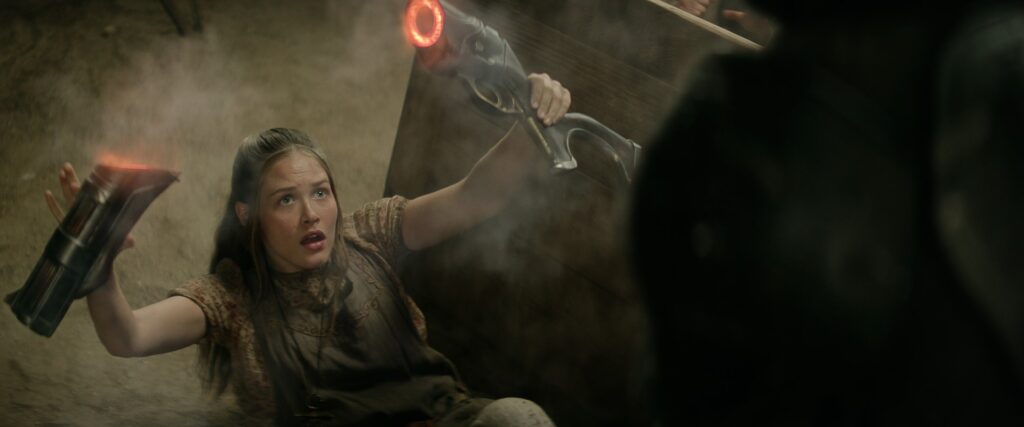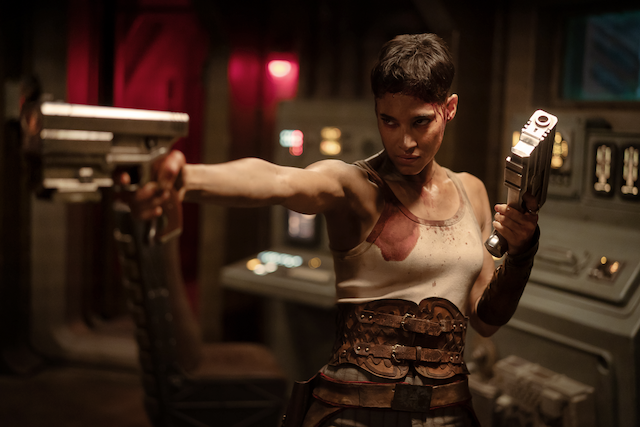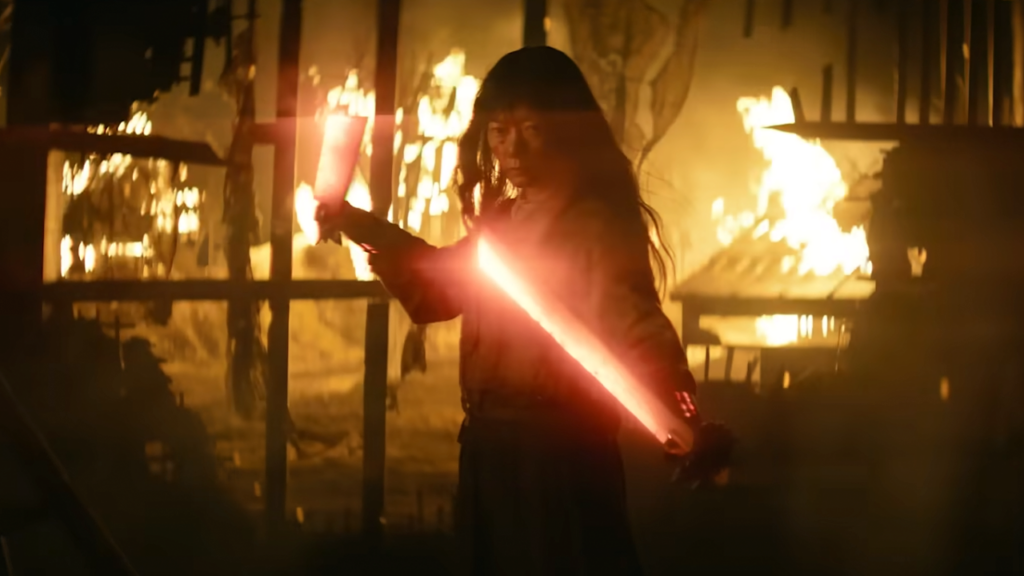Early on in Rebel Moon – Part Two: The Scargiver, Sofia Boutella’s Kora confides in her lover, Gunnar (Michiel Huisman), the truth of her past life as Arthelais, the former Imperium soldier and adopted daughter to Regent Balisarius, in between snapshots of sexual intimacy and a post-coitus cuddle. The PG-13 version currently on Netflix leaves the details of their physical intimacy to the imagination and the R-version coming later this summer will likely indulge more. Regardless, the interweaving of sex and death — an image of the good and the walking Platonic ideal of evil — is Zack Snyder playing with his most basic elements, nothing less than the kernel of the filmmaker.
Snyder doesn’t hide the influence of Seven Samurai on his Rebel Moon franchise– and that’s for the better, because it’s impossible to hide. The first film, Rebel Moon – Part One: A Child of Fire, cuts off shortly after the ragtag team of “samurai” assemble with the defined goal of defending the small farming village from the oppressive invaders coming to steal their crop. The Scargiver resumes with the defense of Veldt against the Motherworld. As the team instructed the villagers on military strategy and trained them in how to fight, I found myself reminded of the words of the El Salvadoran martyr Saint Oscar Romero, whose life was lost standing up for the voiceless poor in the face of a tyrant dictatorship. He spoke of the “violence of love” where “the violence that wills to beat weapons into sickles for work.” The villagers do this by doing exactly the opposite by turning their wheat, a crop needed desperately by the Motherworld, into a weapon (or a deterrent to the Motherworld’s use of certain larger weapons) and by picking up knives and blaster guns when fate calls. Love sometimes demands such a heavy burden of self-sacrifice that one can even call the outpouring of that love violent.
The name “Arthelais” references an obscure Christian saint and foreshadows the rousing and violent synthesis of love and evil in the climatic clash of forces. Justice is what comes from that conflict. In Christian history, Saint Arthelais was miraculously saved by an angel from a kidnapping by the Byzantine emperor of the day and was later deemed a patron of the kidnapped as such. It’s not hard to see why Snyder chose the name, in addition to its admittedly Latin qualities that sound just familiar and just foreign enough to elevate the world-building. The saintly status of the name strikes me as Snyder’s primary purpose with the choice and, even unattached from the historical saint, the name carries something of a stately grace.

Both Rebel Moon films contain quite a bit of religious imagery. The flashbacks of Princess Issa (Stella Grace Fitzgerald), the slain king’s dead child with healing powers, function like moving icons with all of their ornate beauty, bright whites, and symbolic gestures borrowed from real-life spirituality, such as the healing of the dead bird in the first film’s major flashback. Spirituality as a subject keeps a distance from the rebels. In symbolism and imagery, though, spirituality pairs itself indelibly with the defenders of Veldt. In addition to the flashbacks and the name choices, Snyder’s camera (he was also the cinematographer) treats the heroes with a different respect or appreciation than his superheroes; the detail in which he visually centers and approaches their pain, their shortcomings, their moments of emotional vulnerability turns them from superheroes into saints — a definitively more human endeavor for a cinematographer and one less dependent on their action capabilities. The sheer amount of space given to their working of the land to collect the harvest feels sacred somehow; it’s as if in these scenes, a glimpse for the only time the purpose or life source of this community. The rebels even cry and tremble. The only exception is Jimmy (voiced by Anthony Hopkins, body-doubled by Dustin Ceithamer), a robot with an antler crown programmed to protect and serve the slain king. It’s with a curious interest, then, that the Nazi-coded villains from the Motherworld voice what might be the film’s only direct reference to religion.
Ed Skrein gave a remarkable outing as Atticus Noble in A Child of Fire, but he gets dangerously close to the hollowed “it’s a mistake to turn the camera away” kind of villain performance. He makes expert use of every second and even has the power to steal the attention of Boutella’s Kora. The eternally underserved Djimon Hounsou is just as commanding as General Titus. He stares contemplatively right at the camera as if the way his eyes set on the battlefield may implicate the viewer. He’s not just staring down the lens but through the camera and straight into oblivion. The Marvel Cinematic Universe never knew what they had with Hounsou, and Snyder shows them their misstep.
Doona Bae is one of my favorite actors anywhere in the world, and I did lament the reduced role of her dual fire-sword wielding Nemesis. I didn’t clock the run-times or anything like that, but it certainly felt like there was less of her compared to the first entry. She does, thankfully, feature prominently in one of the most memorable scenes in the film — in which a young boy spins around a knife in contemplation of joining the fight before making the decisive action of his life. This scene was one of two that almost drew me to tears, a cinematic occurrence that I only encounter about once a year.
The other was a beautiful scene that showcases Snyder’s idea of heroes at their best and most proletariat. The scene of reference comes right before the doomsday battle when Sam (Charlotte Maggi) dedicates individually crafted tapestries to each of Veldt’s out-of-town saviors as she weaves through an inspirational speech about the qualities of the heroes that protect the town’s sacred grasp on hope. Interestingly, it’s Sam, the pretty farm hand, that Snyder shoots with the visual grammar of heroism. She maintains strong ground near the center of the room and hands the gifts to other children to pass on to the heroes spread throughout the inn, the camera roaming in and out of the space while the real hero — or a representative of the heroic community of peasants — stands firm. Only for Kora does Sam approach the recipient herself. As he does so, the bright white light of the sun peeking in from the window angelically lands on her shoulder just as she passes the gift and speaks about the fate of their people.
These two scenes share a spirited image of heroism, one that contradicts everything the superhero films have taught us. Heroism isn’t some passive wait-game; to be a hero only requires a moment and a decision. Heroism isn’t for the Übermensch but for the peasants.
Rebel Moon – Part Two: The Scargiver
2024
dir. Zack Snyder
123 min.
Streaming on Netflix starting Friday, 4/19
Joshua Polanski is a freelance film and culture writer who writes regularly for the Boston Hassle and In Review Online. He has contributed to the Bay Area Reporter, Off Screen, and DMovies amongst other places. His interests include the technical elements of filmmaking & exhibition, slow & digital cinemas, cinematic sexuality, as well as Eastern and Northern European, East Asian, & Middle Eastern film.



